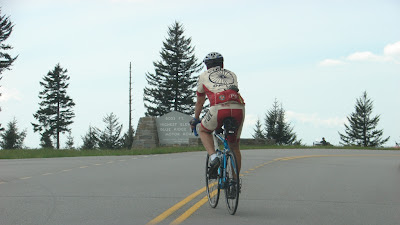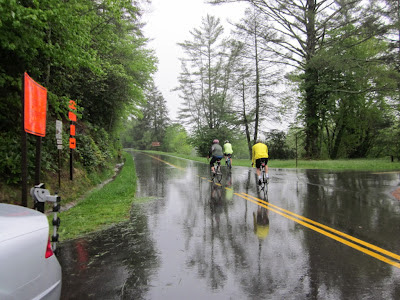 |
| Final group start |
Today, we completed our ride of the
BRP. It was an easy day of 38 miles with 7,500 feet of descent and “only” 3,500
feet of ascent. The descents of 12 and 10 miles each seemed to go on
forever. The weather was overcast, meaning we were in the clouds at elevation. It
was cold coming down the mountains though we warmed up on the climbs.
 |
| We were in the clouds before descending |
Finally we reached mile 469, took some pictures, changed clothes at the nearby Visitors Center, and said our final good byes. Then, Karen and I had a 125 mile, three hour drive home.
 |
| The finish |
 |
| Final Mile marker |
Thanks to my wife Karen for joining
and supporting me during the trip and for driving our car while I was cycling. Thanks
to Jeff Douglas and Mark Koltz for putting up with me for 8 days. I hope I’ll
be a good roommate in September when we ride down the Pacific Coast. Also, thank you to Aila Douglas for
supporting the three of us this week and for keeping Karen company while we
were riding. Karen enjoyed the time spent with you, Aila.
 |
| Thank you, Jeff |
 |
| Thank you, Mark |
A few random thoughts about cycling
the Blue Ridge Parkway follow. Just in case you are reading this and are considering
your own ride. These notes are not in any particular order:
1. The
BRP is 470 miles long and you will climb 49,000 feet, excluding the side trip up
Mount Mitchell. We cycled 452 miles and climbed about 47,500 feet (one section of
parkway was closed for construction). The
ride wasn’t easy, but climbing in the North Georgia Mountains a couple of times
a week for the last four months at 100 feet of climb per mile really helped
prepare me. My endurance was fine, having done a lot of long, slow, and steady training
climbs. Again, thanks to everyone who rides with me at Burnt Mountain and The
Gaps.
2. The
parkway grades weren’t difficult. The length
and frequency of the climbs is what made the ride hard. Most climbs were 6% to 8% grade. Rarely did
my Garmin hit 9% and I can’t recall a single climb that hit 10%. But the climbs
were long and unending. Climbing to Apple Orchard Mountain was 13.7 miles and 3,300
feet. The climb to Waterrock Knob was 8.1 miles and 2,450 feet. Both ends of
the parkway were more difficult than the middle section.
3. There
are virtually no flat sections on the parkway. You won’t be doing any drafting
and likely will be regrouping with your friends at parking outlooks or at the top
of the climbs.
4. Stay
at the two hotels on the parkway if you can. They are Peaks of Otter at mile 86
and the Pisgah Inn at mile 409. The rooms are nice, the views from each room
spectacular, prices reasonable, and the hotel restaurants pretty good. There
are no phones, television, or internet connections at the former and the
internet connection at the latter is somewhat spotty.
5. If
you do your research, there are other hotels not directly on the parkway but
within a quarter mile on private property. We passed several that looked nice
and we stayed at the Woodberry Inn at mile 174 which was very pleasant. The Boone/Blowing
Rock area was a good place to get off the parkway and take a break.
6. Cell
phone coverage is spotty on the parkway. Especially if you have AT&T.
7. You
really need to have front and back lights on your bicycle. Back lights so cars
and motorcycles can see you in bad weather and in tunnels. And a strong front
light for the tunnels, especially the ones over 500 feet long. My front light
was too dim and at mile 399 I encountered the 1,434 foot Pine Mountain Tunnel. That’s
over a quarter of a mile long. And I didn’t know the tunnel curved. After a
couple of hundred feet, I couldn’t see a thing. It was pitch black in the
middle of the tunnel. Try riding your bike at 20mph in the complete dark and
tell me how it went for you. I was lucky I didn’t hit a tunnel wall or an
oncoming car. By the time I saw daylight and got reoriented, I was in the
oncoming lane about 8 feet from the left side wall. In another tunnel, I had
six cars and two motorcycles pass me and I was a little wobbly when they went
by.
8. Keep
two hands on the handlebars at all time. The parkway roads are not as good as
the ones in North Georgia or on the Natchez Trace Parkway. There are potholes,
cracks, and bumps all over the place. The thing I hated most were the small circular
depressions that were maybe six to twelve inches in diameter and an inch
deep and that you couldn’t see until you hit them with your front wheel. No
problem if your hands were on the handlebars, but a moment’s inattention could have
spelled trouble. I kept thinking of Jens Voigt in the 2009 Tour de France. Today
while riding the first downhill at about 30mph, a deer ran across the road
about 10 feet in front of me, but that’s another story…
9. Regarding
Mount Mitchell. You must climb it at mile 355 because the views from the
observation tower at the top are spectacular. The Mount Mitchell road is 4.8
miles long from the junction with the Blue Ridge Parkway to the summit. The
first mile starts at 5% and quickly jumps to 8%. Miles two and three are a
steady 8%. Mile four drops to between 0%
and 5% before the final mile at 8% to 9%.
10. Be
flexible. Allow at least one contingency day for rain if you can. The mountain and valley views are spectacular
the entire 470 miles, but if it is raining you will not see anything and be
miserable. Expect rain; you will be over 4000 feet a good deal in North
Carolina. If you can be flexible on the daily mileage, ride more miles on good
days and back off if the weather is bad. That worked out well for us. Though we
rode in the rain, our rest day was when the weather was at its worst. I thought
the views were the best at the higher elevations in North Carolina, and we were
lucky to have our best weather on those days.
11. There
was more traffic than I thought. Especially in the Roanoke and Asheville areas.
And there were a lot of motorcycles, similar to riding at the North Georgia gaps
on weekends. Most drivers were courteous but someone threw a full can of soda
at Jeff in the Asheville area, and a couple of oblivious elderly drivers came a
little too close for comfort. (I know they were oblivious and elderly because they
were stopped at the next parking outlook.)
12. Our
ride was in early May. At the very start and end of the ride at 2000 foot
elevation, summer gear was fine. During the ride I had to wear arm and leg
warmers, a vest, and either a windbreaker or raincoat every day. Bring rain gear
and be prepared for any type of weather. A cheap hotel shower cap over your
helmet might look funny but it will keep your head warm and dry. Take a lot of
Ziploc bags for your phone, maps, and cue sheets. Bring lots of bars and gels;
you will eat all of them. If you don’t have SAG support, there are some
stretches of parkway without water. So do your research and/or refer to the
book and links mentioned below.
13. The
book Bicycling the Blue Ridge by Elizabeth and Charlie Skinner (©2004)
has elevation charts, the distance and length of all significant climbs, and
mile by mile guides of most everything you need to know about the Blue Ridge Parkway
and Skyline Drive. The links below will also help plan your tour:
Next up is Alabama’s Magnificent
Bicycling Adventure (AMBA) in a week’s time.








































